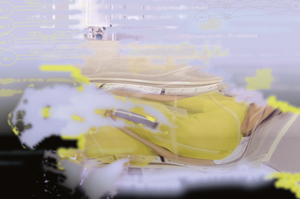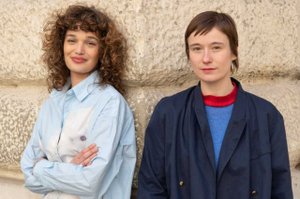Sleepy Politics
How to learn about conviviality and alternative life forms through sleep
An exhibition curated by Francesca Romana Audretsch and Lotti Brockmann with contributions by: Black Power Naps (Fannie Sosa & Niv Acosta), Mustafa Emin Büyükcoşkun & Osman Özarslan, Hannah Cooke, Emil Frederking & Lisa Starmans, Stella Geppert, Inside Job (Ula Lucińska & Michał Knychaus), Jannis Neumann, Cristina Díaz Moreno & Efrén García Grinda, Unstable Bodies (Christian Freude, Christina Jauernik, Johann Lurf, Jonathan Moser, Fabian Puttinger, Rüdiger Suppin), Anna Watzinger
According to sleep research, humans sleep through ⅓ of their lifetime. This statement can be quite sobering when capitalism perceives individual time as a resource, diminishing our sleep phases further and further. The sleeping body becomes a lazy antagonist and the otherwise hard-working body appears useless in the neoliberal ideology. The resulting societal and collective disease patterns are the symptom of a burnt-out and exhausted world.
Together with eleven artistic positions the exhibition Sleepy Politics – How to learn about conviviality and alternative life forms through sleep embarks on a sleepy fieldtrip for new ways of living and solidarity-based forms of togetherness. In the spheres of possibility between sleep, society, and nature, for us, the curators Francesca Romana Audretsch and Lotti Brockmann, the exhibition Sleepy Politics is a lullaby yet a wakeup call from deep sleep. The exhibition offers a platform for an artistic discourse, addressing the multi-faceted appearance of sleeping bodies.
The human need for sleep is dependent on the social and economic accesses to active life. In this way, the question of sleep simultaneously addresses the question of justice and challenges the validity of privileges and hierarchical norms within our society. For the curators, sleeping is a communication form of perceptible care, which arises from methods of collective imagination, intimate transformation, and diverse regeneration. The curatorial practice is understood as a lying act with a horizontal gaze that interweaves artistic positions and searches for alliances. Different themes like radical rest, restless sleep, colonialised sleep, interspecies sleep, repair and sleep, sleep deprivation, queering sleep, non-human sleep, politics of laziness, sleeping resistance, or sleep deprivation and much more open up spaces for thought and action through artistic explorations. The artistic positions make the exhibition a place of encounter for sleep and awakening, rest and movement, dreamlike absence and constant disposition. Therefore, sleep becomes a scene for debating political affairs and practices of resistance. Thus, a space is created where the emancipatory shaping of conviviality is negotiated under the conditions of social, ecological, and political crises.
List of entries
-
–
Conversation 1
Talk as part of the exhibition Sleepy Politics - How to learn about conviviality and alternative life forms through sleep with Lola Olufemi and Christie Costello.
Talk
–
Schillerplatz
Exhibit Gallery
-
Sleepy Politics
How to learn about conviviality and alternative life forms through sleep
An exhibition curated by Francesca Romana Audretsch and Lotti Brockmann.
Opening
Schillerplatz
Exhibit Gallery

-
Sleepy Politics – Guided Tour
Guided tour by curators Francesca Romana Audretsch and Lotti Brockmann.
Guided Tour
Schillerplatz
Exhibit Gallery

-
Conversation 2
Talk as part of the exhibition Sleepy Politics - How to learn about conviviality and alternative life forms through sleep with Mia Imani.
Talk
Schillerplatz
Exhibit Gallery

-
Sleepy Politics – Guided Tour
Guided tour by curators Francesca Romana Audretsch and Lotti Brockmann.
Guided Tour
Schillerplatz
Exhibit Gallery

-
Conversation 3
Talk as part of the exhibition Sleepy Politics - How to learn about conviviality and alternative life forms through sleep with Eva Koťátková.
Talk
Schillerplatz
Exhibit Gallery
![Eva Koťátková during installation for the exhibition [em]What Does a Turtle Feel Through the Carapace?[/em] at Bildmuseet in 2022. Courtesy of the artist and Bildmuseet. Photo: Erik Hillbom. picture of a women with red clothes hanging pictures on a string](https://www.akbild.ac.at/en/museum-and-exhibitions/Exhibit/exhibitions-events/current-exhibitions/2023/sleepy-politics/conversation-3/eva-eva-kotatkova-during-installation-for-the-exhibition-what-does-a-turtle-feel-through-the-carapace-at-bildmuseet-in-2022-courtesy-of-the-artist-and-bildmuseet-photo-erik-hillbom-courtesy-of-the-artist-and-bildmuseet-photo-erik-hillbom.jpg/@@images/image-300-b0cacaf3218f90c6802aecb56108f81f.jpeg)
-
–
Embodied Communication
Workshop with Stella Geppert
Workshop
–
Schillerplatz 3
1010 Vienna
S21Exhibit Gallery
![Stella Geppert, [em]La modulation sismographique[/em], 2023, Photos: Gregoire Avenel Agency Coolhuntparis / background with works by Tania Mouraud](https://www.akbild.ac.at/en/museum-and-exhibitions/Exhibit/exhibitions-events/current-exhibitions/2023/sleepy-politics/embodied-communication/stella_geppert_dnaf23_lamodulation_sismographique_performance_006-kopie.jpg/@@images/image-300-b0cacaf3218f90c6802aecb56108f81f.jpeg)
-
![Exhibition View [em]Sleepy Politics[/em], Exhibit Gallery, 2023, Photo: Simon Veres](https://www.akbild.ac.at/en/museum-and-exhibitions/Exhibit/exhibitions-events/current-exhibitions/2023/sleepy-politics/dsc_7553.jpg/@@images/image-1400-1066e8d72c9ea67ed41d453421fa1e9f.jpeg)
![Exhibition View [em]Sleepy Politics[/em], Exhibit Gallery, 2023, Photo: Simon Veres](https://www.akbild.ac.at/en/museum-and-exhibitions/Exhibit/exhibitions-events/current-exhibitions/2023/sleepy-politics/dsc_7546.jpg/@@images/image-1400-1066e8d72c9ea67ed41d453421fa1e9f.jpeg)
![Exhibition View [em]Sleepy Politics[/em], Exhibit Gallery, 2023, Photo: Simon Veres](https://www.akbild.ac.at/en/museum-and-exhibitions/Exhibit/exhibitions-events/current-exhibitions/2023/sleepy-politics/dsc_7579.jpg/@@images/image-1400-1066e8d72c9ea67ed41d453421fa1e9f.jpeg)

![Exhibition View [em]Sleepy Politics[/em], Exhibit Gallery, 2023, Photo: Simon Veres](https://www.akbild.ac.at/en/museum-and-exhibitions/Exhibit/exhibitions-events/current-exhibitions/2023/sleepy-politics/immersion-collective/dsc_8422.jpg/@@images/image-300-b0cacaf3218f90c6802aecb56108f81f.jpeg)